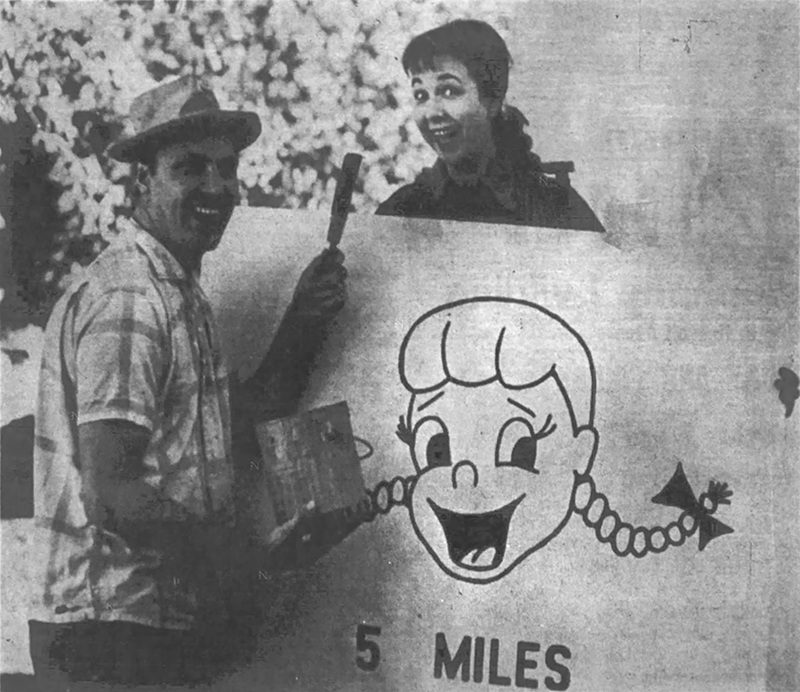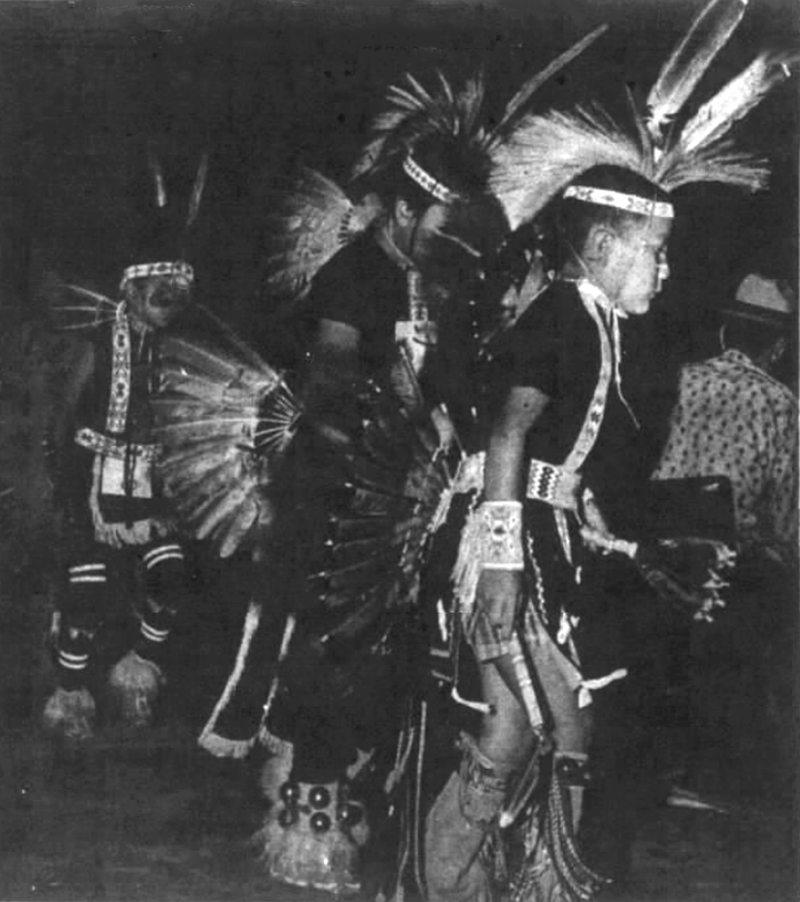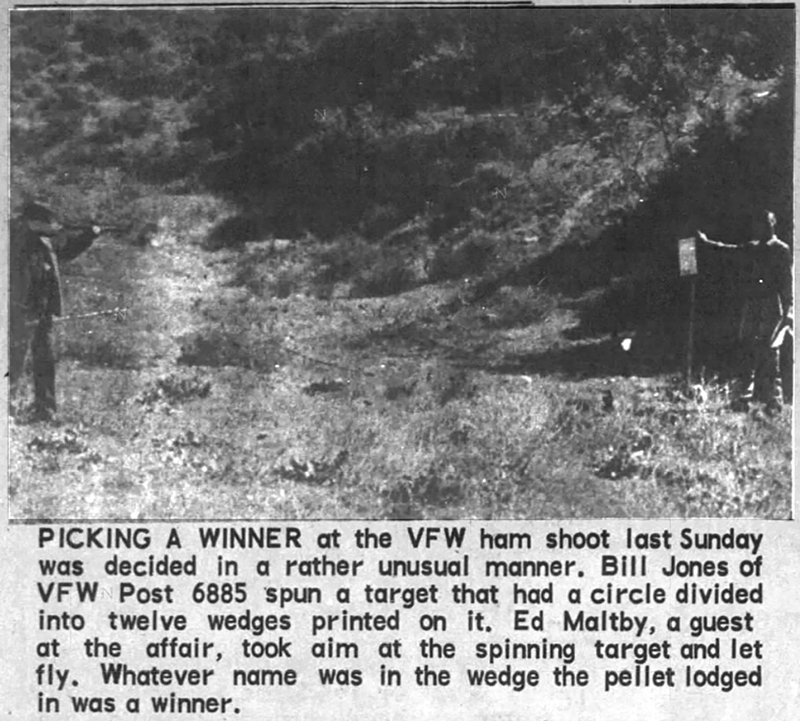|
Today it's mostly vacant land with few physical reminders of a busier time. But from the 1940s-1970s, the east side of Bouquet Canyon Road north of the Texas Canyon turnoff, just below the National Forest boundary, was one of several roadside watering holes in the SCV that kept reinventing itself to attract tourists. Known at various times as the Bouquet Canyon Lodge, Oakhaven, and the Bo-Can Club, its attractions ranged over the years from a large dance hall and rental cabins to horseback riding and authentic Native American powwows. At one point, its owner was a well-known Hollywood actress.
The story begins at the end of World War II when John and Ann Buta of Lomita purchased Clara Redmond's 37-acre ranch property with visions of creating a mountain resort[1] after having operated a successful business at the beach. The real estate agent was the aging former Signal editor A.B. "Dad" Thatcher. It must have been one of his first such transactions; Thatcher went into the land business just four years prior to his death at age 88 in 1949.[2]
The Butas erected a motel, rental cabins and a cafe with a beer bar in 1946.[3] Then, in 1947-1948, they built themselves a 5-room family home on the property, complete with an electric dishwasher.[4] The address was 30554 Bouquet Canyon Road.
John Buta joined the local Chamber of Commerce and got an appointment as the Civil Defense zone warden for Bouquet Canyon.[5] In late 1951 he built stables for horses.[6]
May 17, 1952, was the date of the Butas' grand reopening. Their renamed and remodeled Bouquet Canyon Lodge offered fresh seafood, chicken in a basket, and "liquid refreshments of all kinds."[7] According to The Signal, "A clear, cold mountain brook coming down the canyon from Boquet [sic] reservoir runs through the premises and adds a most attractive feature to the free picnic grounds.[8] ("Boquet" was the common local spelling at the time.)
Three months later, the Butas were dealt a $4,000 setback when one of the cabins went up in flames. The fire spread to surrounding brush.[9]
To raise capital, the Butas mortgaged the lodge to a pair of investors from Beverly Hills, Delbert Arden and Stan Taylor.[10] By early 1954, their rebranded Bouquet Canyon Club was offering dancing[11], fishing in a trout lake, tennis and trap shooting, in addition to food and drink.[12]
A decade before showman Robert Callahan moved his "Indian village" tourist attraction to upper Mint Canyon, John Buta and a new group of L.A.-area investors announced plans in June 1954 for a themed Indian village with a host of recreational activities. From the lack of subsequent news reports, it's unclear if it materialized, but the Broome Brothers Western Band was the house band at Buta's new, 3,000-square-foot dance hall.[13]
The Butas took out another mortgage on their furniture and fixtures in 1955 from Irving and Cecelia Landay of Hollywood.[14] Evidently it wasn't a happy relationship. The lodge was named Landay's Inn when the cafe and cocktail lounge sustained a major fire in October 1956 that caused $10,000 in damage. According to The Signal, a sheriff sergeant had to "referee a vigorous argument between Mr. Ann Buta and Mrs. Landay about how the fire started," prompting an investigation by the arson squad. Landay claimed she'd been cleaning her shoes in the lounge when she dropped the cleaning fluid and the vapor ignited.[15]
John Buta had other interests around town. In the late 1950s he owned a grocery store at 17052 Sierra Highway[16], which today is in the front yard of College of the Canyons' Canyon Country campus. In 1963 he would open a golf driving range just inside the forest at 30552 Bouquet Canyon Road.[17]
By that time, the Butas had gotten out of the Bouquet Canyon hospitality business. In the fall of 1960 they sold the lodge property to Jane Withers, a grown-up child actress from the 1930s-1940s, and her husband Ken Errair of the Four Freshmen, a male singing group that was popular in the 1950s.[18] Withers was still acting; in the mid-1960s she was the recognizable "Josephine the Plumber" in a long-running series of television commercials for Comet cleanser.

Ken Errair and Jane Withers paint a direcitional sign pointing the way to their newly aquired property. Photo: The Signal, November 24, 1960. Click to enlarge.
|
Living in Woodland Hills[19], Withers and Errair spruced up the Bouquet Canyon property, painted on her trademark cartoon little-girl likeness with flashing eyes and pony tails, and renamed the place "Oakhaven."
The couple intended to make it a recreation center with old-fashioned fun for the whole family — as well as a museum for Withers' collection of 3,800 dolls and her movie memorabilia.[20] Future plans included a rodeo arena under management of actor Rod Cameron.[21] They held their inaugural event December 3, 1960: Their first weekly Saturday auction of second-hand items, with pony rides by day and a barn dance at night.[22] Meanwhile, Errair tried his hand at selling agricultural real estate.[23]
Cabins rented for "$12 per week and up,"[24] and the dance hall was offered as a business rental[25] at a time when there were relatively few indoor spaces in the valley that could accommodate large gatherings.
As absentee landlords, Withers and Errair didn't quite realize their vision for the property. According to reports, Bonnie Suraco, scion of an established Bouquet Canyon family, tried to make a go of it in 1965[26] and advertised a "reopening under new management" in May of that year with dining and dancing to a live band. Hours were Fridays and Saturdays from 6 p.m. to closing, and Sundays starting at noon.[27]
That lasted about a year. In 1966 the business sold to Henry Lee Rutherford (1911-1988) and Margaret Salmon Rutherford (1920-1999), who would give it a good decade.

Youth dancers at the 1966 powwow. Photo: The Signal, September 8, 1966. Click to enlarge.
|
The Rutherfords abbreviated the name to the "Bo-Can Club" and reopened May 14, 1966, with dancing on weekends at $1.75 per couple.[28] They ran the place "dry" until their on-sale beer license came through in the summer.[29]
In August 1966, the Rutherfords hosted the first of several competitive Native American powwows sponsored by the American Indian Drum and Feather Club, an intertribal organization.[30]
Whether it was bottles that occasionally went missing from the Butas' bar in the 1950s, a pair of horses that were stolen from Withers and Errair in 1961[31], or a shooting at one of the cabins in 1964[32], larceny and other crimes were part-and-parcel to running a drinking establishment in a remote canyon. In 1966, a pair of men checked their guns at the beer bar and went over to the hall to watch the powwow dancers. Afterward they returned to the bar, retrieved their guns, and pilfered $50 from the till. The owner kindly asked for the money back and wisely decided not to make an issue of it when they declined.[33]
Fires were a constant plague, too. Their very first winter, the Rutherfords lost their cabin home on the property. It was a chilly December day; something must have gone wrong when they tried to heat it.[34] Undeterred, two weeks later they advertised a "Gala New Year's Eve Party" at the Bo-Can Club with "fun for all" and a "generous amount of beer."[35]

The VFW's "ham shoot" at the Bo-Can Club. Photo: The Signal, March 22, 1967. Click to enlarge.
|
A different kind of shooting happened at the Bo-Can Club in March 1967 when the local VFW Post 6885 organized a "ham shoot." Participants fired skeet guns and pellet rifles at various targets. Winners came away with a ham or a coupon for $6 in meat products.[36] L.A. County regulations prohibited the use of standard rifles and pistols.
It wasn't guns but rather knives that turned a birthday party for owner Margaret Rutherford into what The Signal termed a "bloody brawl" in July 1973. As a group of friends from Glendale were leaving the club, they were jumped by a gang of 13- to 18-year-olds from the San Fernando Valley.
By this time, Henry Rutherford was out of the picture; Margaret was running the establishment with her common-law husband Jimmie Dale Mayfield. (They married in 1979 in Reno). Jim Mayfield broke up the bloody birthday brawl by shooting a pistol into the air and holding the hoodlums at gunpoint until deputies arrived. Four youths were arrested, and two of the friends, aged 14 and 31, needed stitches.[37]
Margaret and Jim quit the business in 1975, and it changed hands several times. First came William Ellis Iredale[38], who tried to make a go of it as the Canyon Cafe.[39] By 1976, the owners were Gladys D. Jameson and Dorothy J. Mills.[40] Two years later, as the Bo-Can Club, it transfered to Daryl I. Durant's Bo-K Inc.[41]
After that, it died quietly and alone, making news only when subsequent landowners filed development plans that didn't materialize[42], or when it went into tax default[43] and foreclosure.[44]
Genealogical research assistance provided by Tricia Lemon Putnam.
|
1. The Signal, November 15, 1945.
2. The Signal, February 17, 1949.
3. The Signal, June 27, 1946. Notice of beer license.
4. The Signal, May 27, 1948.
5. The Signal, December 28, 1950.
6. The Signal, September 6, 1951.
7. The Signal, April 3, 1952. Notice of liquor license.
8. The Signal, May 15, 1952.
9. The Signal, August 7, 1952.
10. The Signal, September 18, 1952. Legal notice.
11. The Signal, March 4, 1954. Notice of dance permit application.
12. The Signal, February 18, 1954.
13. The Signal, June 24, 1954.
14. The Signal, September 22, 1955.
15. The Signal, October 4, 1956.
16. The Signal, May 28, 1959.
17. The Signal, May 16, 1963.
18. The Signal, November 3, 1960.
19. Valley News, April 20, 1961.
20. The Signal, November 24, 1960.
21. The Signal, November 3, 1960.
22. The Signal, December 1, 1960. Advertisement.
23. The Signal, May 18, 1961.
24. The Signal, November 12, 1964, and November 18, 1965. Advertisements.
25. The Signal, February 4, 1965.
26. The Signal, September 16, 1965. Notice of transfer of liquor license.
27. The Signal, May 27, 1965.
28. The Signal, May 12, 1966. Advertisement.
29. The Signal, September 11, 1966. Notice of transfer of beer license.
30. The Signal, August 28, 1966, and September 8, 1966. A 1972 powwow sponsored by the Los Angeles Indian Center was noticed in The Signal, June 28 and July 3, 1972. The American Indian Drum and Feather Club returned as the sponsor in 1973, as noticed in The Signal, July 20, 1973. There is no indication powwows were held at the club from 1967-1971.
31. Valley News, April 20, 1961.
32. The Signal, May 21, 1964.
33. The Signal, September 8, 1966.
34. The Signal, December 12, 1966.
35. The Signal, December 28, 1966. Advertisement.
36. The Signal, March 13, 1967, and March 22, 1967.
37. The Signal, July 13, 1973.
38. The Signal, April 23, 1975.
39. The Signal, July 28, 1975.
40. The Signal, January 19, 1976.
41. The Signal, January 18, 1978.
42. The Signal, December 3, 1989.
43. The Signal, August 28, 1997.
44. The Signal, August 13, 2008.
